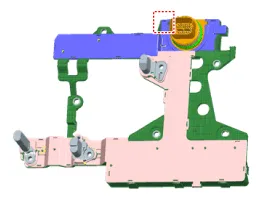Hyundai Genesis (DH): Automatic Transmission Control System / Transmission Oil Temperature Sensor Description and Operation
Hyundai Genesis (DH) 2013-2016 Service Manual / Automatic Transmission System (SBC) / Automatic Transmission Control System / Transmission Oil Temperature Sensor Description and Operation
| Description |
Transmission oil temperature sensor monitors the automatic Transmission fluid's temperature and conveys the readings to TCM.
It is an NTC (Negative Thermal Coefficient) sensor whose
resistance has an inversely proportional relationship with the
temperature level. Data produced by this sensor is used to identify
damper clutch activation and deactivation zones within the low
temperature and high temperature range and to perform hydraulic
amendment control during gear changes.

Removal 1. Turn ignition switch OFF and disconnect the negative (-) battery cable. 2. Remove the cover (A). 3. Disconnect the ECM connector (A), TCM connector (B) and IDB connector (C).
Specifications ? Type: Negative Thermal Coefficient Type Temp.[(
Other information:
Hyundai Genesis (DH) 2013-2016 Service Manual: LKAS Unit Repair procedures
Removal 1. Disconnect the negative (-) battery terminal. 2. Remove the mirror wiring cover (A) and rain sensor cover (B). 3. Remove the LKAS unit connector (A). 4. Remove the LKAS unit after disengaging the mounting bracket (A). Installation 1.
Hyundai Genesis (DH) 2013-2016 Service Manual: Components and Components Location
S
Categories
- Manuals Home
- Hyundai Genesis Owners Manual
- Hyundai Genesis Service Manual
- Heating, Ventilation and Air Conditioning
- Suspension System
- Smart Cruise Control Unit Repair procedures
- New on site
- Most important about car
Copyright В© 2026 www.hgenesisdh.com - 0.021
